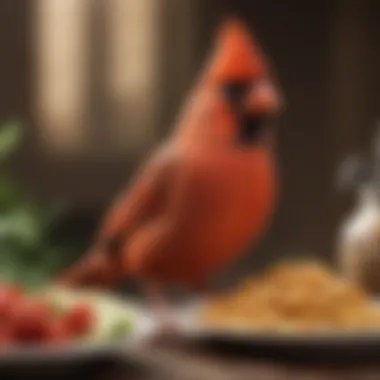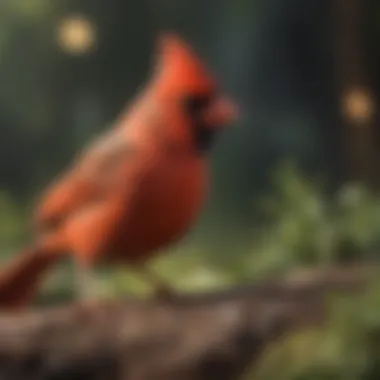Unveiling the Unique Dietary Needs of Cardinals: Vital Feed for Cardinal Health


Animal Species Profile
Cardinals are known for their striking appearance and distinctive red plumage that sets them apart from other bird species. Their vibrant coloring, especially the males' bright red bodies, makes them easily recognizable in any natural setting. Cardinals are medium-sized songbirds with a crest on their heads, adding to their regal and elegant demeanor. These birds are native to North and South America, and their presence is a delight to bird watchers and nature enthusiasts.
Physical Characteristics and Appearance
The physical characteristics of cardinals are truly captivating. They typically have a strong, conical beak ideal for cracking seeds and nuts, which form a significant part of their diet. The males sport brilliant red plumage, while the females exhibit a more subdued coloration, with primarily grayish-brown feathers and red accents on their wings and tails. Both sexes have distinctive black facial masks and a prominent crest atop their heads.
Natural Habitat and Distribution
Cardinals prefer habitats with dense vegetation, shrubby areas, and woodland edges. They are often found in gardens, parks, and forested regions, providing a beautiful contrast against the greenery with their vivid hues. These birds are widespread across North and South America, with different subspecies adapting to various climates and environments within the continent.
Behavior and Social Interactions
In terms of behavior, cardinals are known for their melodious songs, making them a musical presence in their territories. They are monogamous birds, with pairs forming strong bonds and engaging in mutual grooming to reinforce their relationship. Cardinals are territorial and will defend their nesting sites vigorously, even against larger birds. Their social interactions involve complex displays of courtship and communication through various vocalizations and body postures.
Introduction
Understanding Cardinals' Dietary Needs
In this section, we will delve into the intricate dietary requirements of cardinals, emphasizing the specific foods crucial for their well-being. Cardinals are known for their selective eating habits, necessitating a focused approach when catering to their nutritional needs.
Dietary Specificity of Cardinals
The dietary specificity of cardinals refers to their distinctive food preferences that play a significant role in their overall health. Cardinals are primarily seed-eaters, with a preference for seeds such as black oil sunflower seeds and safflower seeds. These seeds provide essential nutrients and energy for cardinals, supporting their metabolic functions and vitality.
Cardinals' preference for seeds makes them unique among bird species, as they rely heavily on this type of food source to meet their dietary requirements. Understanding this aspect of their diet is crucial for providing adequate nutrition to attract and support cardinals in outdoor spaces.
The affinity of cardinals for seeds stems from their physiology and behavior, making it a beneficial choice to include in feeders designed to attract these colorful birds. By offering a variety of seeds tailored to their preferences, individuals can create an inviting environment that encourages cardinals to frequent bird feeders and enriches the wildlife experience.


Stay tuned for the next sections focusing on essential foods for cardinals, creating an ideal cardinal feeding station, attracting cardinals with food, and supplementary feeding considerations, providing a holistic approach to supporting these magnificent avian creatures.
Essential Foods for Cardinals
When delving into the dietary needs of cardinals, it is imperative to understand the significance of providing essential foods that cater specifically to their requirements. Rendering the right balance of nutrients is crucial for the health and well-being of these vibrant birds. By focusing on essential foods tailored for cardinals, one can enhance their overall vitality and ensure they thrive in their natural habitat.
Seeds
Seeds serve as a fundamental component of a cardinal's diet, offering an array of nutritional benefits essential to their sustenance. Among the various seed options available, Black Oil Sunflower Seeds stand out as a top choice for cardinals due to their high oil content and rich nutritional profile. These seeds provide a significant source of energy for cardinals, aiding in maintaining their stamina and supporting their metabolic functions.
Black Oil Sunflower Seeds
Black Oil Sunflower Seeds play a pivotal role in the diet of cardinals, known for their robust outer shell and higher oil concentration compared to conventional sunflower seeds. The accessibility and nutritional density of Black Oil Sunflower Seeds make them a preferred option for attracting cardinals to feeding stations. Despite their superior nutritional value, these seeds require proper storage to prevent spoilage and maintain their freshness.
Safflower Seeds
Incorporating Safflower Seeds into a cardinal's diet offers a different nutritional profile compared to sunflower seeds, diversifying their nutrient intake. Safflower seeds boast a thicker shell, deterring unwanted pests while providing cardinals with a source of essential fatty acids and protein. Cardinals are known to favor safflower seeds due to their mild flavor and crunchy texture, making them a suitable addition to their diet.
Berries
Berries constitute another vital component of a cardinal's diet, offering a natural source of vitamins, antioxidants, and hydration. Elderberries stand out for their deep purple hue and potent antioxidant properties, serving as a valuable supplement to a cardinal's daily diet. Mulberries, on the other hand, provide a sweet and tangy flavor profile, enriching the sensory experience for cardinals while delivering essential nutrients.
Elderberries
Elderberries are prized for their rich antioxidant content, aiding in boosting the immune system of cardinals and promoting overall health. The vibrant color of elderberries indicates their high anthocyanin content, which offers anti-inflammatory and immune-boosting benefits. Incorporating elderberries into a cardinal's diet can positively impact their longevity and vitality.
Mulberries
Mulberries are a favored fruit among cardinals, known for their juicy texture and sweet flavor. These berries are packed with essential nutrients, including vitamin C, fiber, and antioxidants, providing cardinals with a wholesome snack option. By offering mulberries as part of a cardinal's diet, one can introduce variety and nutrient diversity to support their overall well-being.


Insects
Insects play a crucial role in a cardinal's diet, serving as a primary source of protein and essential nutrients. Crickets offer a convenient and protein-rich food source for cardinals, aiding in muscle development and energy production. Mealworms, on the other hand, provide a versatile option packed with protein and vital amino acids, supporting the metabolic functions of cardinals.
Crickets
Crickets are valued for their protein content and ease of digestion, making them a suitable choice for cardinals' dietary requirements. The high protein concentration in crickets contributes to muscle growth and repair in cardinals, supporting their physical development and overall vitality. By incorporating crickets into a cardinal's diet, one can ensure they receive sufficient protein for optimal health.
Mealworms
Mealworms offer a convenient and nutrient-dense food source for cardinals, supplying essential proteins and amino acids vital for their growth and energy levels. The versatility of mealworms allows for various feeding strategies, from offering live mealworms to incorporating dried or rehydrated options based on the cardinal's preferences. Including mealworms in a cardinal's diet helps meet their protein requirements and enhances their foraging experience.
Nuts
Nuts serve as a caloric powerhouse for cardinals, providing essential fats, proteins, and minerals necessary for their daily activities. Peanuts offer a convenient and energy-rich option for cardinals, supplying them with the necessary fuel for sustained flight and physical exertion. Almonds, known for their crunchy texture and nutrient density, add a nutritious element to a cardinal's diet, supporting their overall nutritional requirements.
Peanuts
Peanuts are a favored nut choice for cardinals, valued for their high energy content and easy accessibility at feeding stations. The abundance of fats and proteins in peanuts offers cardinals a quick energy boost, ideal for sustaining their active lifestyle. However, caution must be taken to ensure peanuts are unsalted and free from molds to prevent any potential health risks for cardinals.
Almonds
Almonds present a nutrient-dense option for cardinals, packed with essential vitamins, minerals, and antioxidants. The crunchy texture of almonds provides cardinals with both mental stimulation and nutritional benefits, making them a well-rounded snack choice. By incorporating almonds into a cardinal's diet in moderation, one can enhance their overall nutritional intake and promote their physical well-being.
Creating an Ideal Cardinal Feeding Station
When considering the dietary needs of cardinals, the aspect of creating an ideal feeding station holds utmost importance. An ideal feeding station plays a crucial role in providing a suitable environment for these vibrant birds to access their essential food. It serves as a hub for cardinals to gather, feed, and thrive in a secure setting.
A cardinal feeding station serves as a focal point for attracting these birds, offering them a consistent and reliable source of nourishment. By creating an ideal feeding station, individuals can significantly contribute to the well-being and sustenance of cardinals in their surroundings.


One essential element to consider when setting up a feeding station is the type of food and feeders used. Cardinals are known to prefer specific foods such as seeds, berries, insects, and nuts. Adorn the feeding station with a variety of these food options to cater to the diverse dietary needs of cardinals, ensuring a balanced diet for their optimal health.
The placement and accessibility of the feeding station are pivotal factors that influence its effectiveness in attracting cardinals. Placing the station in a strategic location that is easily accessible to these birds is key. Ensuring that the station is visible and positioned in areas frequented by cardinals increases the likelihood of their visitation and fosters a sense of comfort and safety while feeding.
Moreover, the accessibility of the feeding station plays a significant role in the convenience and ease of feeding for cardinals. A well-designed station with considerations for easy reach for the birds enhances their feeding experience. Cardinals are more likely to return to a station that offers effortless access to food, promoting their regular visitation and fostering a bond with the feeding spot.
In summary, creating an ideal cardinal feeding station involves meticulous planning and attention to detail. From selecting the right food options to strategically placing the station for maximum visibility and accessibility, every aspect contributes to the overall success of attracting and supporting these magnificent birds. By prioritizing the creation of an optimal feeding station, individuals can play a vital role in conserving and nurturing the cardinal population in their vicinity.
Attracting Cardinals with Food
Attracting cardinals with food plays a crucial role in nurturing these magnificent birds. Cardinals have specific dietary needs that must be met to ensure their health and well-being. By providing appropriate food, individuals can attract and support cardinals in their natural habitat. Understanding the importance of offering the right foods to attract cardinals enhances the overall bird-watching experience and contributes to the preservation of these beautiful creatures.
To effectively attract cardinals, individuals must consider various elements. Choosing the right types of seeds, berries, insects, and nuts that are favored by cardinals is essential. Creating an inviting feeding station that is easily accessible to cardinals while strategically located ensures that these birds feel comfortable and safe while feeding. By incorporating suitable food sources and designing feeding areas that cater to cardinals' preferences, individuals can attract these vibrant birds and observe them up close.
Landscaping Tips
Native Plants
Native plants play a pivotal role in attracting cardinals due to their unique characteristics and benefits. Native plants are locally indigenous species that have adapted to the region's climate and soil conditions over time. These plants provide a familiar and natural habitat for cardinals, offering them food sources and shelter.
The key characteristic of native plants lies in their resilience and ability to thrive without excessive maintenance. They attract cardinals by producing fruits, seeds, and flowers that are integral to the birds' diet. Native plants promote biodiversity, creating a balanced ecosystem that supports not only cardinals but other wildlife as well.
Sheltered Feeding Areas
Sheltered feeding areas are essential for cardinals as they offer protection from predators and inclement weather conditions. These areas provide a safe environment for cardinals to feed without feeling threatened or exposed. The key characteristic of sheltered feeding areas is their ability to mimic the natural sheltered spots that cardinals seek in their habitat.
Creating sheltered feeding areas involves incorporating structures or natural elements that shield cardinals from harsh winds and direct sunlight. By placing feeders near bushes, trees, or other structures, individuals can create a secluded space where cardinals feel secure while feeding. Sheltered feeding areas enhance the overall feeding experience for cardinals, encouraging their frequent visits and prolonged stay in a welcoming environment.
Supplementary Feeding Considerations
In the realm of cardinal care, it is imperative to delve into the supplementary feeding considerations that can significantly impact the birds' health and overall well-being. Supplementary feeding goes beyond merely providing essential foods; it involves meticulous attention to details that can make a substantial difference in attracting and supporting these vibrant avian creatures. Understanding the nuances of supplementary feeding considerations is crucial for anyone aspiring to create a cardinal-friendly environment. By incorporating these considerations into the feeding routine, individuals can enhance the quality of life for cardinals in their vicinity.
Maintaining Cleanliness
Regular Cleaning Practices
The cornerstone of a successful cardinal feeding program lies in the disciplined implementation of regular cleaning practices. The practice of maintaining cleanliness in the feeding station is not merely a chore but a fundamental aspect of ensuring the birds' health and safety. Regular cleaning practices involve activities such as removing leftover food, clearing away droppings, and sanitizing feeders. This meticulous attention to cleanliness deters the accumulation of contaminants that could potentially harm the cardinals. One key characteristic of regular cleaning practices is their proactive nature, preventing potential health risks before they arise. This proactive approach is why regular cleaning practices are not only a popular but a necessary choice for maintaining a healthy environment for cardinals. The unique feature of regular cleaning practices lies in their preventive nature, as they act as a barrier against diseases and infections that can afflict birds. The advantages of regular cleaning practices in this context are abundant, ranging from promoting cardinal well-being to fostering a conducive feeding environment that attracts more of these fascinating creatures.







